Seafield
Houses within 15km of this house
Displaying 28 houses.
Houses within 15km of Seafield
Displaying 28 houses.
| House name | Description | |
|---|---|---|
| Castletown | At the time of Griffith's Valuation, James Fenton was leasing the house at Castletown to George Fenton when it was valued at £10. In 1906 the property at Castletown was owned by Thomas G. Fenton and was valued at £11. It is no longer extant though traces of walls, stable yard and gate lodges are all still visible. | |
| Scurmore | In 1786 Wilson writes that Scurmore House was the seat of Mr. Nisbett. Later, in the nineteenth century it became a seat of the Wingfields. In the 1830s it is described as undergoing repairs but the family were again occupying it by 1857. The house is recorded as the property of S.L. Lewis in 1906 when it was valued at £37. McTernan states that the house was demolished in the mid twentieth century. A later house now exists at the site but the original outbuildings are still intact. | |
| Fortland | Wilson, writing in 1786 refers to "Fortland, pleasantly situated on the banks of the river Easky" as the seat of Mr. Browne. It later passed to the Jones estate. Both Leet in 1814 and Lewis in 1837 record it as a Jones property. In the mid nineteenth century it was bought by Richard Graves Brinkley who was leasing it to John Wingfield King at the time of Griffith's Valuation when it was valued at £14. It was offered for sale in the Landed Estates Court in 1874 when it was occupied by Mrs. Charlotte Lloyd, presumably a relative of Richard Brinkley's wife, Hester Lloyd. In 1906 it was the property of John L. Brinkley and was valued at £39. McTernan notes that the house was afterwards damaged by fire and partially demolished. Various buildings, including substantial remains of an estate farmyard, survive at this site. |
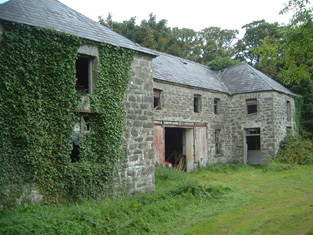
|
| Temple View | The house now known as Temple View was built in the later 19th century. At the time of Griffith's Valuation there was a building at this location owned by Peter Hale and leased to George Fenton. In 1906 Temple View was the property of James Hale and was valued at £32 as well as other buildings in the townland. McTernan states that it had a succession of owners through the twentieth century but has been vacant for long periods. In 2005 it was derelict and for sale. |
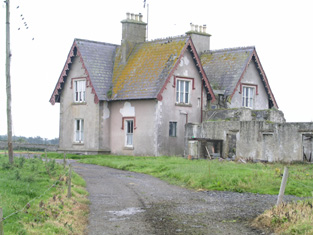
|
| Rathlee | At the time of Griffith's Valuation Thomas Jones was leasing a property valued at £18 at Rathlee, barony of Tireragh, to John Christie. The ''Sligo Directory'' of 1862 indicates that John Christie was a magistrate for the county. McTernan states that this property was associated with the Hewitt family who were connected with the Fitzgerald family through marriage. The Fitzgeralds had acquired an interest in the property at the beginning of the nineteenth century. In 1814 Leet recorded the house at Rathlee as the residence of Michael Fitzgerald. Rathlee is no longer extant but the remains of the walled garden are still visible. | |
| Oghil | Oghil house is recorded in the OS Name Books as being built in the 1740s, though McTernan states that the existing house dates from the late 1830s. At both the time of Griffith's Valuation and in 1906 it was the property of Robert W. Armstrong and was valued at £17. It later served as the parochial house but is now a family home again. See http://www.westsligo.com/culleens/historyoghillhse.htm for more details. |

|
| Kinard Lodge | The Ordnance Survey Name Books record Kinnard Lodge as the property of the Paget family in 1837. It appears that it, like other houses in the area, was used as a summer bathing lodge. At the time of Griffith's Valuation, it was occupied by James Paget and was valued at £9. A second house in the townland was occupied by Henry Simpson, leasing from James Paget, and was valued at £6. Kinard Lodge is still extant and occupied. | |
| Dromore | At the time of Griffith's Valuation the house at Dromore was the property of John Fenton and was valued at £15. Both Leet in 1814 and Lewis in 1837 also record it as a residence of the Fenton family. In 1864 Thomas Fenton offered it for sale in the Landed Estates Court. The house was occupied at the time by Jas. McMunn, MD. In 1906 the house at Dromore was valued at £16 and was the property of William Browne Loughead. |

|
| Woodhill House | At the time of Griffith's Valuation Lewis Jones was leasing Woodhill house, valued at £25, at Knockaculleen, barony of Tireragh, from Anne Jones. When the property was offered for sale in the Landed Estates Court in May 1875 the house is described as " a handsome modern residence valued at £30". The Wingfield King estate sold their interest in the property in 1879 and the sale notice mentions Thaddeus Tiernan as occupying the house at that time. In 1906 a house here valued at £20 was the property of Thaddeus Tiernan. McTernan states that this gentleman had amassed a fortune in Australia and South America. He became involved in public life, including Board of Guardians and County Council, on taking up residence at Woodhill. The house is still owned by his descendents. |

|
| Farrenmacfarrell | James Ormsby was occupying this property at the time of Griffith's Valuation, when it was valued at £6. McTernan states that the house was built by Thomas Ormsby at the end of the eighteenth century. In 1906, the house at Farranmacfarrell was owned by Alexander Cuffe and was valued at £7. The house is still extant but appears to be unoccupied. | |
| Charlesfort House | Charlesfort House was the home of Rev. William Grove in 1836. It was also occupied by him at the time of Griffith's Valuation when it was valued at £13. | |
| Seaview or Doonecoy | The Hillas family seem to have occupied the house at Carrowmacrory since the eighteenth century as McTernan notes that it was built by Robert Hillas who was High Sheriff of Sligo in 1772. Mrs. Esther Hillas was occupying the house, valued at £25, at the time of Griffith's Valuation. In 1906 it was the property of Robert G. Hillas and was valued at £23. The house was eventually sold in 1955 to the O'Beirne family by whom it is still owned. |

|
| Corkhill House | Sir Malby Crofton is recorded as the lessor of two properties in the parish of Templeboy at the time of Griffith's Valuation. One property is noted as a herd's house, valued at £1 while the second, valued at £1 5s, was leased to Thomas Fury. McTernan notes that in the eighteenth century this house had been leased from the Crofton estate by the Wood family. It eventually fell into disrepair and was demolished. | |
| Belville (Kilmacshalgan) | According to McTernan, Belville was built by Peter Rutledge on the occasion of his marriage to Catherine Ormsby in 1808. The house was occupied in the 1830s by James Rutledge. At the time of Griffith's Valuation, it was occupied by Margaret Ormsby Ruttledge, leasing from the Cooper estate and was valued at almost £4. By 1876 it was the seat of Robert McMunn who owned 582 acres in county Sligo. It was partly demolished in the twentieth century. | |
| Kilglass | At the time of Griffith's Valuation a house at Kilglass, barony of Tireragh, valued at £35, was being leased by Richard Verschoyle from the Ecclesiastical Commissioners. In 1906 the house at Kilglass was owned by Henry McCarrick and was valued at £37. The house appears to have been known as Kilglass Lodge at the time of the 1st Ordnance Survey. |
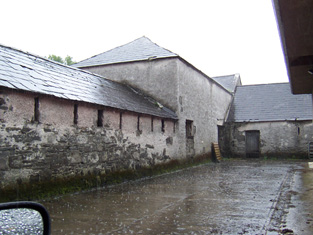
|
| Bunowna | In 1906 John L. Brinkley was the owner of a property at Bunowna, barony of Tireragh, valued at £7. At the time of Griffith's Valuation, James McMunn, MD, had been leasing this property from the Brinkley estate, when it was valued at £8. The property is labelled Bridge House on the 25-inch Ordnance Survey map of the 1890s. It is still extant. |

|
| Cooga Lodge | The house at Cooga was valued at £26 in 1906 and was the property of John Howley.At the time of Griffith's Valuation Patrick Howley had a steward's house here, valued at £4, together with 300 acres. [Grid Reference is approximate]. Local folklore suggests it afterwards became the residence of the local priest. |

|
| Kilmacurkan | In 1906 John L. Brinkley owned property valued at £20 at Kilmacurkan, barony of Tireragh. At the time of Griffith's Valuation the only building on his lands here was a herd's house valued at 5s. A substantial building is indicated on the 25-inch Ordnance Survey map of the 1890s but no trace of this remains now. Local sources indicate that this was a scutch/flax mill, of which the ruins still stand including the traces of the flax ponds, various sheds, etc that are present on the 1890 map. | |
| Ballygreighen | In 1906 Henry E. King owned over 350 acres of untenanted land and buildings valued at £10, at Ballygreighen, barony of Tireragh. At the time of Griffith's Valuation Andrew Finnegan was leasing a property valued at £8 from the King estate at Ballygreighen. The original buildings is no longer extant. | |
| Seaville or Seaview House | At the time of Griffith's Valuation James Kerr was leasing a house valued at £12 at Carrownurlaur from the Wingfield estate. It is labelled Seaville House on the First Edition Ordnance Survey map but as Seaview House on the later 25-inch edition of hte 1890s. Portion of the original building remains. | |
| Orme's Lodge | Robert Orme was the owner of several properties in the village of Enniscrone, Carrowhubbuck South, barony of Tireragh, at the time of Griffith's Valuation. These properties had valuations of between £12 and £20. McTernan notes that one of these was Orme's Lodge which remained in the family until the 1930s. It subsequently became a hotel and was demolished in the 1990s to make way for new house building. |
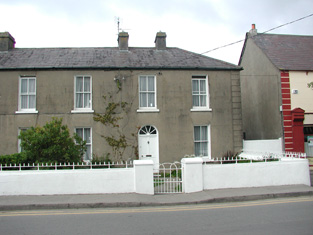
|
| Cuffe House or Camcuil | Camcuill townland was part of Peter Niddrie's estate at the time of Griffith's Valuation. The house with highest value was that of Edward Larrinan, leasing a property valued at £3 from Peter Niddrie. McTernan states that the house had originally belonged to the Brownes and later the Jones family of Fortland. In 1874 the sale notice referring to the Niddrie estate mentions Camcuill as "a comfortable dwelling house with extensive offices, recently erected". In 1906 a house in this townland is recorded as the property of the representatives of Grace Niddrie. |
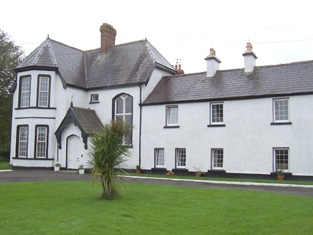
|
| Knockaculleen A | At the time of Griffith's Valuation, William Rutledge was leasing a house valued at almost £10 at Knockaculleen, barony of Tireragh, to Catherine Rutledge. [Grid reference is approximate]. | |
| Fort Laurel | Patrick and Hugh Maguire were leasing over 60 acres from the Palmer estate at Ardogelly at the time of Griffith's Valuation. Fort Laurel House was later built at this property. It was renovated in the late twentieth century and is now a family home. |
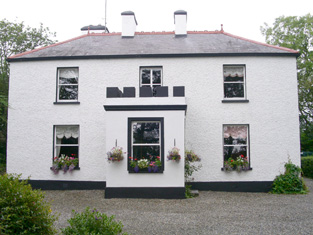
|
| Finned (Tireragh) | At the time of Griffith's Valuation, George Beatty (or Beattie) was leasing a house valued at £5 and almost 100 acres from the Tottenham estate. McTernan states that he was referred to at the time of the Ordnance Survey as a "middleman for a large amount of property". Later the house passed by marriage to the Boyd family who sold it in the early twentieth century. It is still extant and has been renovated. |

|
| Roslea Cottage | A house built after the publication of the first Ordnance Survey map. It was leased by Hugh Kivilican from the Brinkley estate at the time of Griffith's Valuation when it was valued at £3. It is still extant though in need of restoration and in 2012 was offered for sale. |
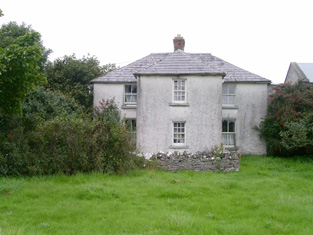
|
| Grangemore (Tireragh) | In 1786 Wilson refers to Grange as the seat of Mr. Jones. It is possible that he is referring to the house then at Grangemore, in the parish of Templeboy. By the time of Griffith's Valuation, this townland was part of the estate of William Phibbs and the house, occupied by Thomas McKinn, was valued at £3. McTernan writes that in the mid-17th century, this property was known as Curhow and was owned by Theophilus Jones. It was subsequently sublet to the Wood family and purchased by Phibbs from the Cooper of Coopershill estate in the 1790s. | |
| Prospect House | The National Inventory of Architectural Heritage dates the building of this house to about 1770. Slater’s Directory records John Thompson of Prospect House in 1846. At the time of Griffith’s Valuation this house was vacant but held by Mary A. Sanderson of Cloverhill. This house is now a ruin. |

